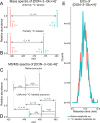MetExtract II: A Software Suite for Stable Isotope-Assisted Untargeted Metabolomics
- PMID: 28787149
- PMCID: PMC5588095
- DOI: 10.1021/acs.analchem.7b02518
MetExtract II: A Software Suite for Stable Isotope-Assisted Untargeted Metabolomics
Abstract
Stable isotope labeling (SIL) techniques have the potential to enhance different aspects of liquid chromatography-high-resolution mass spectrometry (LC-HRMS)-based untargeted metabolomics methods including metabolite detection, annotation of unknown metabolites, and comparative quantification. In this work, we present MetExtract II, a software toolbox for detection of biologically derived compounds. It exploits SIL-specific isotope patterns and elution profiles in LC-HRMS(/MS) data. The toolbox consists of three complementary modules: M1 (AllExtract) uses mixtures of uniformly highly isotope-enriched and native biological samples for selective detection of the entire accessible metabolome. M2 (TracExtract) is particularly suited to probe the metabolism of endogenous or exogenous secondary metabolites and facilitates the untargeted screening of tracer derivatives from concurrently metabolized native and uniformly labeled tracer substances. With M3 (FragExtract), tandem mass spectrometry (MS/MS) fragments of corresponding native and uniformly labeled ions are evaluated and automatically assigned with putative sum formulas. Generated results can be graphically illustrated and exported as a comprehensive data matrix that contains all detected pairs of native and labeled metabolite ions that can be used for database queries, metabolome-wide internal standardization, and statistical analysis. The software, associated documentation, and sample data sets are freely available for noncommercial use at http://metabolomics-ifa.boku.ac.at/metextractII .
Conflict of interest statement
The authors declare no competing financial interest.
Figures


References
Publication types
MeSH terms
Grants and funding
LinkOut - more resources
Full Text Sources
Other Literature Sources

